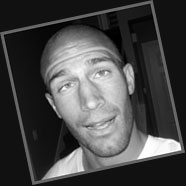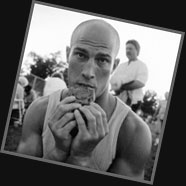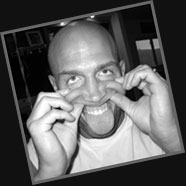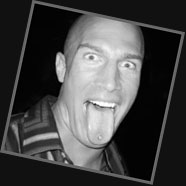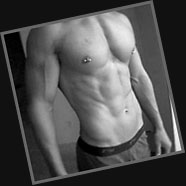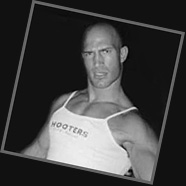How To Become A Male Model
Hello! My name is Eric Watson and amoung other things I am a male model. I also built this website, so I am not just a "pretty face". And as you can see by my portfolio, I've been around the block as it were. Therefore, it's safe for you to assume that I know what I'm talking about when it comes to the world of modeling. My hope is that this article helps you on your journey to become a successful model, or at the very least, helps you navigate through it's merky waters!
What is Male Modeling?
Hmmm... male modeling, where should I begin? First I will assume those reading this are aspiring models themselves. Either that or you’re looking for information on how to further your carrier as a model. In this article I will try and explain what this vague subject of male modeling is, and what it is not. I will explain how I became a successful model, and I will suggest ways that will help you do the same. We will examine the do's-and-don'ts of this often superficial and shady world. We will also go over what you should expect and what you should not expect; be it your own success or your failed attempt. And lastly, I will briefly get in to what I enjoyed about modeling and what I didn't.
Modeling Attributes
First let’s get into the attributes one must first have to even have a chance of being a model in the first place. Misconception number one: you have to be good looking - false! Sure it helps to be attractive, but it is not a necessity. A model can either be good looking, or equally as valuable if not more, unique looking! Or of course a combination of the two, like myself fore instance (just kidding, Ha Ha, He He). Misconception number two: you have to be tall - true and false! Modeling agencies, and clients alike, prefer their models to be between 6'0" and 6'2" and boast a 40 regular suit size. However with that said, there are plenty of exceptions to that rule as well. There are lots of markets (e.g. print work) where the not so tall model can thrive. Misconception number three: you have to be skinny - false! Once again for some god-knows reason modeling agencies and their clients prefer almost slickly looking models. And once again there are plenty of exceptions that rule as well in fact. I myself am a "big" example of one - literally! Now you may not fit into any of these categories, but you'll never know for sure if your model material until you try. However, for your own sake, you don't want to be like one of those on American Idol contestants (the ones in the gag reels) constantly reaching for false hopes. Don't get me wrong, when I first tried to become a model I got turned down by every modeling agency there was. So there is also a lot to be said for determination, and not taking the word “No” for an answer. So that's best left up to you to determine which category you fall into.
How I Became a Model
Trying to become a model is, in one way at least, sort of like trying to become a race care driver; unless you know someone that can walk you through the steps involved, it’s somewhat difficult to know where to begin. Therefore, I will briefly give some history on me and the steps that I took to become a model. So...around the age of nineteen (I’m thirty three years old now) I set of to try and become a model. It turned out to be a very short lived attempt. Via the phone/phone book, I found some agencies up in LA, and in high spirits I set off to what I thought would be a somewhat easy experience; after all, everyone always said that I was "sooooo good looking"!
The first modeling agency I went to wouldn’t even see me. They said "you need to have photos of yourself that we can look at - or head shots". The second and third modeling agencies went somewhat the same. So, a few weeks later, and armed with my newly taken photos (from the best class year book photographer around), I ventured back to LA to give it another shot. It went pretty much like this - NO! - NO! - NO! - NO! - NO! But, one of them did give me a list of all the agencies in LA; about fifteen of them our so. So being the determined type, I got back into my car a visited every last one of them. The rest went pretty much the same. The best answer I got was, come back when you have lost twenty or thirty pounds. Mind you, I weighed about 225lbs at the time. WOW, that did not go as planned! Oh well I thought... how’s that saying go...? It’s better to of tried and failed than to of never tried at all. So after hearing "No" from fifteen different agencies, I thought that was a pretty definitive answer. So for the time being, that quest was over and my new quest to become a personal trainer began; but that’s for another day.
About a year later, and working now as a personal trainer, and weighing five pounds less I might add, my friend and I were up in Vegas doing some heavy drinking and partying when a young man approached me. He was a model scout for an agency in LA. He gave me a few bloated complements, his card, and told me that I needed to come and visit his bosses’ agency called Notorious Model Management. I really did not think much of it, after all, it was "Vegas" at three in the morning, how legit could it really be? After recovering from my Vegas trip (that took a few days) I went to the modeling agency, as suggested, and met with a man named Roger. He later turned out to be my good friend and the person who would help launch my modeling career. And the rest is history as they would say! So that’s how I got my foot in the door and began my ten year modeling career (five of which were full-time and five were half-time). I would venture to say that my personal experience would be the exception and not the rule. If I were to do it again (I fully plan to when I retire at the age of around fifty five), and knowing what I know now, this is how I would go about doing it, and these are the following steps that I would suggest taking.
Steps To Take To Become A Model
First, as we learned earlier, go and get some nice professional photos taken, however, not from a class year book photographer! I would suggest getting on to the internet, finding some local agencies in or around your area, and calling them. Tell them that you are an aspiring model and that you are "really - really - good looking" (just kidding, don’t say that). Honestly, tell them that you would like to get some photographs first before you come for a face-to-face. Then, ask them if they know of any, or work with any photographers that might be willing to do a test shoot with you? Most likely they will know of some local photographers that will be more than willing to shoot you (i.e. take pictures of you). Either that or they can most likely point you in the right direction. See here is how it works. Just as there are an abundance of aspiring models, there are also many aspiring fashion photographers. Just as you are trying to put together a portfolio of your best photos, each photographer is also trying to do the same. So they will most likely shoot you for free or a small nominal fee; this will vary. So you see, you are basically just using each other to accomplish the same goal. (Note: if or when you become a "big name model", these same photographers will pay YOU to let them take pictures of you). You see, because you being the big model that you are now, would make the photographers portfolio look that much better.
Types of Photos
To generalize, there are two different types of photos that you can get. One would be model/fashion shots, and the other would head-shots. Head-shots are just that - a photo of your head. They can either be black and white or color, but if I remember correctly they're usually black and white (I tried to stay away from the acting scene). These are primarily for actors to take with them on casting-calls (this is where they show case how good they are at "pretending"). But you are trying to become a model right? So model/fashion photos are what you should be after. There is really no definition of these, they just won’t be boring black and white pictures of your face. They will definitely be a little edgy! You’re mainly just trying to find your best angle here in order to show the potential modeling agencies what you look like behind the camera. I’ve even been surprised at times the way that a fellow model looked in person as compared to how he or she photographed.
Go Get An Agency!
OK, now… with our photos in hand go get an agency! Go online or call prior, because each will have their own specific times in which they do open-calls (i.e. walk-ins). In the beginning, and while just trying to get your foot in the door, you'd probably be best off signing on with which ever agency is willing to represent you; so be somewhat choosy, but not picky. However, if you get lucky, as I did, and your first agency believes in you and really pushes for you, then great, stay right there with that agent and don’t move, for a while at least. (Note: you're only as good looking, and as sought after as your agent/booker believes you to be). Everyone in the business of modeling is a follower (lots of sheep – not to many herders). So be it your first agency or your third, what you should be looking for is someone that believes in you and who will ultimately get you a lot of work! With that said, I have always had a lot of luck with smaller to medium size agencies, and the ones that only represent male models. With the larger agencies I tended to get lost in the shuffle, so to say. Basically what I am saying is, that it does not fully matter what the name says on the wall outside. What matters most is the person on the phone all day calling perspective clients and getting your name out there, and if he or she pushes for you. However, each situation is different, so once again, this is a decision best left up to you.
The Client
See here is how it works. The client wants to sell something. Therefore the client needs a model to help sell their product. If the client has done this before they will call the modeling agency that they are familiar working with, and/or have a good relationship with. (Note: that’s why it’s somewhat important that your agent is nice person). If the client has "not" done this before, he or she will go online, phone, or phone book to find a reputable agency. This is when it works to the advantage of the larger agency with the most well known name (i.e. usually one of the biggest). The client will tell the agent what they are selling and what type of model that they are looking for to help sell it. This is when it is in the hands of the agent; for he or she decides which models they send over to the client. (Note: if you happen to be one of the models being sent – be on time!) Aside from the way you look and act, this is one of your biggest assets. It’s very reassuring to the client if they can fully trust that you will show, and show on time. At this point the client will narrow down their decision to the top two or three or so. They WILL deliberate on it until usually about 24hrs before the actual job takes place. With no warning what so ever, I even once received a phone call at 2am telling me that I needed to be on a plane at 6am in LA (two hours away), to fly to Paris. I went of course, but I was not happy about it.
Where You Rate
Once you have been in the business for a while, done some jobs, and had some time to figure out where you rank within the agency hierarchy and the modeling world alike, it’s time to decide if you should stay put or move-on. Are you working? Does the agent believe in you and go-to-bat for you? Do they run their business in a professional manner? Are they nice? Do you get paid on-time? (Note: on-time in the modeling business is a vague concept at best. It usually takes anywhere from four to six months from the time of your job till the time you get paid, depending on the client and the agency). If I learned anything in this business I learned this - don't ever become complacent! At the very least, if a couple of months go by with no work or word from your agent, it's time to move-on! (Note: you are only as good looking, and as sought after as your face is new). What's that mean? For me at least, I always worked heavily during the first year with either a new agent or within a new market (i.e. new city). But after that first year, give or take, my amount of work usually slowly trickled off and eventually slowed. Every models particular situation will be different. So you may find that this is the case for you as well, or it may not be. One of the reasons being is that there are many different modeling mediums. There is print-work modeling, fashion, catalogue, runway, fitness, show-room, fit-model, bathing suit, body part, editorial, commercial, and the ever coveted "cologne campaigns". So you may have the type of look that gets more regular paying jobs, like with catalogue or fit-modeling fore instance. However for the most part, that was not me. I found my niche early on and I would suggest you do the same. I was more along the lines of shock-and-awe. I would come into a new market, get all the big jobs and big money, and then just as quickly as I was new and interesting, they would quickly bore of my look, and therefore, the jobs would dry up. (Note: therefore - you find your niche - you find your fame and fortune!
Modeling Agencies
Now you ask - how many different agencies can one have? That is completely up to you, the model. You can, or rather should, only have one agent per major city. Otherwise you will have agents stepping on other agents toes, and they don't like that one bit (i.e. lots of cat fights that you do not want to be in the middle of). You will want to have what they call a "mother agency". Your mother agency can be any agency of your choosing. Primarily, your mother agency will be the one that you feel the most allegiance to, or is the most professional, or gets you the most work, or the one that you have the best rapport with, or simple the agency that you were with first. The decision is yours to make. The mother agent will hold your books (i.e. your schedule). So any other agents that you have are "supposed" to contact them first before they schedule you for a job. This is done in order to avoid any scheduling conflicts. (Note: there are a lot of pride issues that go on at this juncture between the different agencies. So to be on the safe side, it's a good idea that you also call your mother agency and let them know when you have been booked for a job through a different agency). I even always took it one step further and told all my agencies when another agency even just placed a hold on me. A "hold" is an agencies way of reserving an X amount of days on you so that another client or agency cannot book you during that time period. Basically, when a client narrows down their decision to their top two or three, all those models will most likely be placed on hold. I am sure now you are starting to see how it is very easy for scheduling conflicts to occur. The suggestions just mentioned go along way to help keep everyone working harmoniously with one another. Because when they don't, and it will happen eventually, your stuck in the middle with your hands tide with everyone yelling back and forth at one another!
Aside from the very beginning, I always had a minimum of three agencies working for me at all times, and each in a different part of the world. As a rule of thumb, I would say don't have over five different agencies at any one time (to much to keep track of). I have had about twenty different agencies over the ten years that I modeled. Most of them, I eventually moved-on from, some dissolved under their own accord, and a couple dropped me. (Note: this is a business of flakes. So established, big named agencies are usually in it for the long-haul, but many agencies are also the fly-by-night type). There are a lot of major cities that span the globe. So you see, as long as you continue to work at it (i.e. never become "complacent") you will have an endless amount of markets to showcase your “new” and fresh face in. Once you get some time under your belt you will have a better understanding for how it all works. You may find that a certain city has not dried up, but rather the agent has. In which case, just change agents, don’t necessarily remove yourself from that city. There are a few major markets around the world that you will want to continually make your presence felt. In order to be the best model you can be you MUST have an agency representing you in at least one (preferably more than one) of the following major markets. These cities are as follows and in no particular order: Los Angles CA, Miami FL, New York NY, San Francisco Ca, Paris France, Milan Italy, London UK, Madrid Spain, Barcelona Spain, and Cape Town South Africa
The Money
Now lets to the good stuff, and one of the main reasons you’re probably reading this article to begin with - the money! Well, sadly to say the majority of models that enter into this business will not make very much money doing it. However, a small percentage of models do make a good living, and a few even make a fortune. Where you fall into that category is determined by a few things: the way you look, the way you act, the choices you make, the agencies that represent you, the jobs you get, and a little luck. Like I said earlier, everyone in this business is a follower. You can go from a "nobody" (in their eyes at least) to a "somebody" over night. If you get a high profile job like a cologne campaign or a Calvin Klein campaign you will be instantly wanted and adored by every agency and client alike. I was lucky enough to do just that right off the bat. However, my cologne campaign was in Europe, so that’s where my fame a fortune took off, for the most part. I saw a little fame in the United States, but nothing in comparison to over seas. That was a good thing though – for me at least. I could fly over to Europe, work for a couple of weeks, sign some autographs, get pampered, and then quickly come back to the US and reenter the "real world". I was able to make a good living while I worked as a model full-time for five years, and I made a good amount of money on the side while I worked part-time for my remaining five years as a model. But enough about me, lets get back to you, your job options, and roughly what each pays.
Types of Modeling Jobs
First off, the money that you receive for any given job is determined by three things: the type of job itself, who you are and strength of your book (i.e. your portfolio), and the influence of your agency. I would say that each carry an equal amount of weight when it comes to determining your worth (i.e. hourly rate, daily rate, or by the job).
Campaigns
Lets start off with the big money, cologne campaigns, or manly anything with the word "campaign" on the end of it. These pay big, and how! Campaigns typically buy you out for the year and carry a contract of a given term along with them. Basically the contract says that you can't do another ad that is the same as the campaign ad in question for the amount of time that they have contracted to pay you for. Usually the contract amount will increase by around 10% to 15% each year. To give an example, and I don't even know the ads name, but I am sure you have seen the same guy doing the same cologne campaign for about ten years now (same as I have). Well he most likely got paid somewhere in and around 50K for the first year and it has most likely increased 10% to15% each and every year thereafter. Ya - WOW! Mind you, this is all for one picture he took ten years ago. He most likely has not had to lift a single finger since.
Print-Work & Catalogue
OK, then there's print-work and catalogue work, like Marcy's, ads in magazines, and news paper clothing ads. These pay handsomely as well. No where near the realm of campaigns, but there strength lies in their regularity. Catalogue work typically pays around $1500 to $2500 a day and the shoots are repeated often; it's a plush job! Print-work in general pays around the same and the regularity of the work will depend on the type of job itself.
Show-Room & Fit-Modeling
Show-room and fit-modeling are another example of a plush gig. Basically you stand there and model different outfits so the client can see the clothes on a "real person" verses a manikin. This pays the same, around $1500 to $2500 a day. It doesn't get much easier than this, but it is also extremely boring!
Fitness Modeling
Then there is fitness and bathing suit modeling. These usually do not pay much of anything. Bathing suit modeling may depending on the job, but fitness definitely does not pay squat. I did the Men's Health cover about six or seven times and for each of the first five I was only paid $150 – and that's for the cover! Inside the magazine is even worse. For the next two I wised-up and demanded more and received $750 for each. (Note: contrary to popular belief, magazine covers, be it Men's Health or Vogue, don't pay anymore than around $150 usually). Reason being, they figure that anyone would jump at the chance to be on a cover and further there carrier; and they'd be right.
Run-Way & Editorial
Finally there's run-way and editorial modeling. Once again I have grouped these together because they also pay next-to-nil. We have all seen editorials in magazines and thought to ourselves, geeze that was sort of a strange couple of pages I just flipped through? Well that my friend, was an editorial. In short, editorials are page fillers, and a venue for photographers and clients to showcase there work and clothing. In the process the model gets some good face-time and usually some really good shots for his or her book. These pay either nothing or around $150 - are you seeing a trend yet? This $150 number just keeps coming up! This is why it’s hard to make a decent living as a model. Then there is run-way modeling. This type of modeling is by far and away the most fun and gratifying. For a model, there is nothing better than to have all eyes on you as you strut your stuff down the run-way. (Note: I always would pound a 40oz before going on stage – loosened my nerves and made it a little more enjoyable). However, unless you are extremely good at holding your alcohol, I would suggest limiting your intake to a 12oz. Nothing would end a run-way career faster than making a spectacle of yourself for all eyes to see. Run-way modeling pay tends to vary a lot. Some pay in clothing, some pay any where from $150 to $750, while others pay nothing. Once again, and same as magazine covers, they figure that they can get anyone to jump at the chance to walk the runway; and once again they'd be right! They say that doing run-ways is good for a models carrier. I however, never noticed any change in my work load after doing the run-ways during New York Fashion Week (for two consecutive years).
Suggestions
Here are a few extra suggestions to help make you a successful model. I would suggest keeping your own records when it comes to the money side of things. I always kept detailed records on the dates, the money that was promised me, the agency the job was contracted through, and the client I was working for. In a "perfect" world you would not have to do this because everyone would be honest and pay you what you are due. But as I'm sure you are learning by now, this is not a perfect world. Most agencies will pay you on-time and run their business in a professional manner, but some won't. In that case, it will be up to you to get your money; by either repeatable calling the agent, or in extreme circumstances, I have even been known to go above the agents head and have the client pay me directly and then I gave the agent his or her cut (which by the way is usually around 20%). Obviously, if I had to go to these extreme measures then I would later say good bye to this particular agency. But my point being, this will even happen to the best of us now and again, so when it does, don't just let it go – fight tooth and nail for every penny your owed!
The Photographer
When shooting with a photographer, get in tune with him or her. For those moments that he or she is clicking away, you two are a team, and should be working well with one another. This is your moment to shine - so don't blow it! Each photographer has a different style and a different way of shooting. In my day, I shot with all of the top photographers, some were easy to get into a smooth flow with and some were not. (Note: most of the best and talented photographers are considered the best for a reason, so just follow along and learn). I believe it’s up to the model to adjust their style to always match the photographers. Their click speed, how they like to set-up a shot, do they want lot's of smiles or serious looks, are they going for the natural or posed look? (Note: give the client and the photographer what they want, after all that's what the client is paying you for. Don't make them feel like they're pulling teeth to get it). Countless times, I've worked along side other models and watched as the clients and the photographers continuously rolled their eyes and shook there heads in frustration at these other nameless models. Needless to say, these particular models most likely did not get a return invitation. This I think is a big one! I was always really good at this. The photographer seldomly had to tell me how to move, look, or act. I quickly developed a reputation for being a true professional and a pleasure to work with. (Note: this is what gets you repeat business from clients).
Likes and Dislikes
I liked the fame and fortune and that’s about all I liked. For me everything else was not so much fun. For me the traveling part was the actual job, and the modeling job itself was the easy part. Still to this day, due to all the flying I did, I prefer to drive when at all possible, even if it takes twice as long. Another dislike of mine would be all the millions of castings I had to go on. (Note: once in the business for a while and after developing a strong book, I no longer had to go on castings anymore). For the most part the agent would only have to send out my comp-card/zed-card (i.e. displays your best photos on a 5 x 7 card) to the clients. This is a big plus when you make it to the top. I am somewhat of a "power-tripper", so I was never fond of the uncertainty of it all. When am I going to get my next job? When am I going to get paid for my last job? When will I get to come home? I always had a girl-friend (that I would painfully miss) back at home waiting for me. Also, I always had it in my mind that I should be faithful to whom ever it was, so needless to say, I never really... Mmmm... lets say... "capitalized" on my situation, so it was always a somewhat painful experience for me in this regards.
Why I Stopped
I stopped modeling (full-time) because it was becoming too hard to maintain with my current jobs. Initially, I stopped doing it full-time because I did not want to be "just" a model for my entire life. Modeling is a very easy and fun way to make some extra cash on the side, but while doing so, I would suggest that you continue to follow your other aspirations as well. With that said, when I retire from my current jobs I fully plan on returning to the world of modeling and making a big comeback around the age of fifty five or so. For men at least, there is still a strong market for that age. I figure at that time I'll be a big fish in a small pond – that's good for business! Reason being, most people let themselves go by that age and turn into a "big-pile-of-poo". I will not!
Good Luck!
This article got a little longer than I had originally planned, but I guess there was a lot of information that I felt I needed to give you. So thanks for sticking in there until the end, and I hope this article helps you on your quest to become the best model that you can be! Here are also some helpful links and modeling resources to help point you in the right direction. Good Luck!










